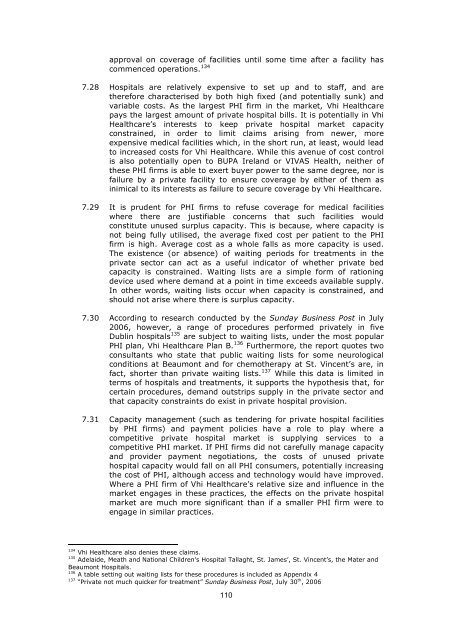Competition in the Irish Private Health Insurance Market
Competition in the Irish Private Health Insurance Market
Competition in the Irish Private Health Insurance Market
You also want an ePaper? Increase the reach of your titles
YUMPU automatically turns print PDFs into web optimized ePapers that Google loves.
approval on coverage of facilities until some time after a facility has<br />
commenced operations. 134<br />
7.28 Hospitals are relatively expensive to set up and to staff, and are<br />
<strong>the</strong>refore characterised by both high fixed (and potentially sunk) and<br />
variable costs. As <strong>the</strong> largest PHI firm <strong>in</strong> <strong>the</strong> market, Vhi <strong>Health</strong>care<br />
pays <strong>the</strong> largest amount of private hospital bills. It is potentially <strong>in</strong> Vhi<br />
<strong>Health</strong>care’s <strong>in</strong>terests to keep private hospital market capacity<br />
constra<strong>in</strong>ed, <strong>in</strong> order to limit claims aris<strong>in</strong>g from newer, more<br />
expensive medical facilities which, <strong>in</strong> <strong>the</strong> short run, at least, would lead<br />
to <strong>in</strong>creased costs for Vhi <strong>Health</strong>care. While this avenue of cost control<br />
is also potentially open to BUPA Ireland or VIVAS <strong>Health</strong>, nei<strong>the</strong>r of<br />
<strong>the</strong>se PHI firms is able to exert buyer power to <strong>the</strong> same degree, nor is<br />
failure by a private facility to ensure coverage by ei<strong>the</strong>r of <strong>the</strong>m as<br />
<strong>in</strong>imical to its <strong>in</strong>terests as failure to secure coverage by Vhi <strong>Health</strong>care.<br />
7.29 It is prudent for PHI firms to refuse coverage for medical facilities<br />
where <strong>the</strong>re are justifiable concerns that such facilities would<br />
constitute unused surplus capacity. This is because, where capacity is<br />
not be<strong>in</strong>g fully utilised, <strong>the</strong> average fixed cost per patient to <strong>the</strong> PHI<br />
firm is high. Average cost as a whole falls as more capacity is used.<br />
The existence (or absence) of wait<strong>in</strong>g periods for treatments <strong>in</strong> <strong>the</strong><br />
private sector can act as a useful <strong>in</strong>dicator of whe<strong>the</strong>r private bed<br />
capacity is constra<strong>in</strong>ed. Wait<strong>in</strong>g lists are a simple form of ration<strong>in</strong>g<br />
device used where demand at a po<strong>in</strong>t <strong>in</strong> time exceeds available supply.<br />
In o<strong>the</strong>r words, wait<strong>in</strong>g lists occur when capacity is constra<strong>in</strong>ed, and<br />
should not arise where <strong>the</strong>re is surplus capacity.<br />
7.30 Accord<strong>in</strong>g to research conducted by <strong>the</strong> Sunday Bus<strong>in</strong>ess Post <strong>in</strong> July<br />
2006, however, a range of procedures performed privately <strong>in</strong> five<br />
Dubl<strong>in</strong> hospitals 135 are subject to wait<strong>in</strong>g lists, under <strong>the</strong> most popular<br />
PHI plan, Vhi <strong>Health</strong>care Plan B. 136 Fur<strong>the</strong>rmore, <strong>the</strong> report quotes two<br />
consultants who state that public wait<strong>in</strong>g lists for some neurological<br />
conditions at Beaumont and for chemo<strong>the</strong>rapy at St. V<strong>in</strong>cent’s are, <strong>in</strong><br />
fact, shorter than private wait<strong>in</strong>g lists. 137 While this data is limited <strong>in</strong><br />
terms of hospitals and treatments, it supports <strong>the</strong> hypo<strong>the</strong>sis that, for<br />
certa<strong>in</strong> procedures, demand outstrips supply <strong>in</strong> <strong>the</strong> private sector and<br />
that capacity constra<strong>in</strong>ts do exist <strong>in</strong> private hospital provision.<br />
7.31 Capacity management (such as tender<strong>in</strong>g for private hospital facilities<br />
by PHI firms) and payment policies have a role to play where a<br />
competitive private hospital market is supply<strong>in</strong>g services to a<br />
competitive PHI market. If PHI firms did not carefully manage capacity<br />
and provider payment negotiations, <strong>the</strong> costs of unused private<br />
hospital capacity would fall on all PHI consumers, potentially <strong>in</strong>creas<strong>in</strong>g<br />
<strong>the</strong> cost of PHI, although access and technology would have improved.<br />
Where a PHI firm of Vhi <strong>Health</strong>care’s relative size and <strong>in</strong>fluence <strong>in</strong> <strong>the</strong><br />
market engages <strong>in</strong> <strong>the</strong>se practices, <strong>the</strong> effects on <strong>the</strong> private hospital<br />
market are much more significant than if a smaller PHI firm were to<br />
engage <strong>in</strong> similar practices.<br />
134 Vhi <strong>Health</strong>care also denies <strong>the</strong>se claims.<br />
135 Adelaide, Meath and National Children’s Hospital Tallaght, St. James’, St. V<strong>in</strong>cent’s, <strong>the</strong> Mater and<br />
Beaumont Hospitals.<br />
136 A table sett<strong>in</strong>g out wait<strong>in</strong>g lists for <strong>the</strong>se procedures is <strong>in</strong>cluded as Appendix 4<br />
137 “<strong>Private</strong> not much quicker for treatment” Sunday Bus<strong>in</strong>ess Post, July 30 th , 2006<br />
110







